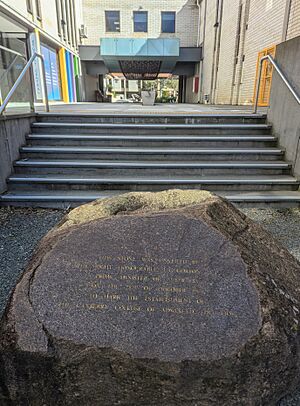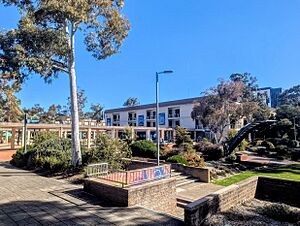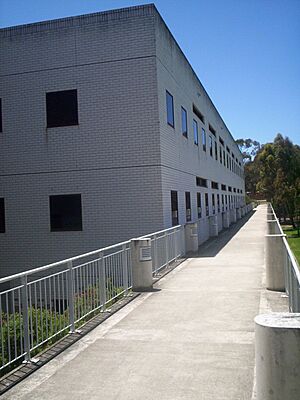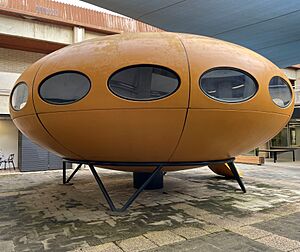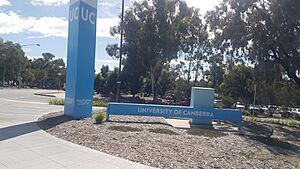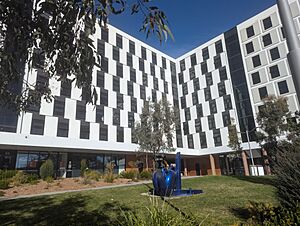University of Canberra facts for kids
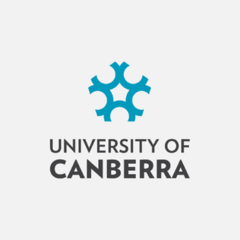 |
|
|
Former name
|
|
|---|---|
| Motto |
Ngunawal: Galambany
|
|
Motto in English
|
"We all, including you" |
| Type | Public research university |
| Established |
|
| Accreditation | TEQSA |
| Affiliation | Innovative Research Universities (IRU) |
| Budget | A$398.04 million (2023) |
| Chancellor | Lisa Paul |
| Vice-Chancellor | Bill Shorten |
|
Total staff
|
1,322 regular (2023) 276 casual (2023) |
| Students | 11,518 (EFTSL, 2023) |
| Undergraduates | 7,729 (2023) |
| Postgraduates | 2,908 (2023) |
|
Other students
|
459 UC College (2023) |
| Address |
11 Kirinari Street
,
,
,
2617
,
Australia
|
| Campus | Urban |
| Colours | Blue |
|
Sporting affiliations
|
|
| Mascot | Cappie the Giraffe |
The University of Canberra (UC) is a public university in Australia. It is known for its research and has its main campus in Bruce, Canberra. The campus is close to the Belconnen Town Centre. UC offers many courses for students who have finished high school and for those who want to study further. These courses are offered through five main study areas called faculties.
Contents
A Look at UC's History
The University of Canberra started in 1967. Back then, it was called the Canberra College of Advanced Education. It became a full university in 1990. This happened with help from Monash University.
The Foundation Stone
A special stone marks the beginning of the university. Australia's Prime Minister, John Gorton, officially revealed this stone on October 28, 1968. You can find it near Building 1 on the Bruce campus. The stone has words carved into it that explain its purpose.
Stonefest: A Campus Tradition
Since 1971, the university has held an annual celebration. It started as "Stone Day" and grew into a popular music festival. Stone Day used to happen after classes finished for the year, right before exams. It was a fun event with local bands playing music.
Over time, the celebration became bigger. In 1976, it expanded to a whole week and was called "Stoneweek." In the 1980s and 1990s, Stoneweek was a very popular event in Canberra. It became one of Australia's most well-known music festivals. In 2000, the festival was renamed "Stonefest."
Stonefest took a break for a few years starting in 2012. In 2014, a smaller version was held, but it wasn't as popular. The full Stonefest returned in 2019 with both Australian and international music acts. It did not happen in 2020 and 2021 because of the COVID-19 pandemic. Stonefest came back again in 2022.
Campus Life and Buildings
Exploring the Bruce Campus
The main campus of the University of Canberra is in Bruce. It covers a large area with many buildings, sports fields, gardens, and walkways. The campus is special because of its native gardens and the kangaroos that live there. There are over 29 buildings used for teaching, research, and administration. These buildings are mostly found around the main concourse. Many buildings are simply numbered instead of having names. At the north end of the campus, you'll find the University of Canberra Hospital, which helps people with rehabilitation.
Campus Facilities
The Refectory is in Building 1. It has a food court, a shop, pool tables, and lounge areas. It also hosts concerts. Upstairs, students and staff can book study rooms.
The Hub is located under the main concourse. It has a café, a hair salon, a tattoo shop, and a student radio station studio (87.8 UCFM). There's also a bar, a convenience store, and other places to eat near the student housing.
A sport and fitness centre is in Building 29. It has gym equipment and is home to the Brumbies Rugby team's offices. Nearby, in Building 4, there are courts for basketball and squash. The campus also has various outdoor sports fields.
How the University is Run
University Council and Leadership
The University of Canberra is managed by its University Council. The current leader of the Council is the Chancellor, Lisa Paul. She is a former senior Australian public servant.
The university also has a Vice-Chancellor (VC) who leads the daily operations. Stephen Parker was the interim VC. He had been the VC before, from 2007 to 2016. He took over after Paddy Nixon left in December 2023. Bill Shorten will become the new VC in February 2025.
Study Areas and Departments
The university has five main study areas, called faculties:
- Arts and Design
This faculty focuses on subjects like architecture, graphic design, communication, journalism, creative writing, and media arts. It has two schools: the School of Design and the Built Environment, and the School of Arts and Communication.
- Business, Government and Law
Here, you can study accounting, business, economics, finance, law, management, marketing, politics, and urban planning. This faculty has three schools: Canberra Business School, Canberra Law School, and Canberra School of Politics, Economics & Society.
- Education
The Education faculty offers courses for future teachers. These courses cover teaching young children, primary school students, and high school students.
- Health
The Faculty of Health prepares students for many health careers. These include nursing, midwifery, nutrition, occupational therapy, optometry, pharmacy, physiotherapy, psychology, and speech pathology.
- Science and Technology
This faculty trains students in environmental sciences, biomedical and forensic sciences, information technology, engineering, and mathematics. It has two schools: the School of Science, and the School of Information Technology and Systems.
University Funding
Like most universities in Australia, the University of Canberra gets most of its money from the Australian Government. This includes student fees and money for research projects. The local ACT Government also provides a small part of the university's budget.
In 2022, the university's budget was around $312.84 million. In 2024, the university faced a financial challenge. This led to plans for saving money, including reducing staff numbers by mid-2025. This was partly due to fewer international students enrolling.
Research and Learning
Research Areas
The university has several research centres. These centres focus on different areas of research:
- Canberra Urban and Regional Futures
- Centre for Ageing Research and Translation (CARAT)
- Centre for Creative and Cultural Research
- Centre for Research and Action in Public Health
- Centre for Research in Therapeutic Solutions
- Collaborative Indigenous Research Initiative
- Health Research Institute
- Institute for Applied Ecology
- Institute for Governance and Policy Analysis
- Invasive Animals Cooperative Research Centre
- Murray-Darling Basin Futures Collaborative Research Network
- Nexus Research Centre
- News and Media Research Centre
- Research Institute for Sport and Exercise
- STEM Education Research Centre
- SYNERGY Nursing and Midwifery Research Centre
The University Library
The University of Canberra Library is located in Building 8. It is a large building with four floors.
University Rankings
| University rankings | |
|---|---|
| QS World | =494 |
| ARWU World | 801–900 |
| US News World | =847 |
| Australian rankings | |
Universities are often ranked to show how well they are doing. Here's how the University of Canberra has been ranked:
- Australian Rankings
In 2024, the Australian Financial Review ranked the University of Canberra as the 26th best university in Australia.
- Global Rankings
- The QS World University Rankings for 2026 placed UC at #494 globally. This made it the 27th best in Australia.
- The Times Higher Education World University Rankings for 2025 ranked UC between #401 and #500 worldwide.
- The Academic Ranking of World Universities for 2024 placed UC between #801 and #900 globally.
- U.S. News & World Report ranked UC at #847 globally for 2025–2026.
- The CWTS Leiden Ranking for 2024 placed UC at #1266 globally.
Student Success
The Australian Government surveys students to see how they are doing. These surveys look at things like student experience and job outcomes after graduation.
In 2023, employers were happy with 78.3% of UC graduates. This shows that students are well-prepared for jobs.
Also in 2023, 85.3% of undergraduate students found full-time jobs after graduating. For postgraduate students, this rate was even higher at 92.9%. The starting salaries for graduates were also good.
In the 2023 Student Experience Survey, undergraduate students rated their overall education experience at 72.7%. Postgraduate students rated theirs at 74.5%.
Partnerships and Connections
UC works with two local schools: UC Senior Secondary College Lake Ginninderra and University of Canberra High School Kaleen. The University of Canberra College helps students get ready for university, including international students. UC also works with the Canberra Institute of Technology. This helps students move between the two places and share special facilities.
Student Life at UC
Student Community
More than 100,000 students have graduated from the University of Canberra since 1970. The university has about 11,000 to 12,000 full-time students each year.
Student Media
Students at UC run their own independent radio station, 87.8 UCFM. It broadcasts from the main campus.
Sports and Athletics
The University of Canberra supports several sports teams. It sponsors the University of Canberra Capitals, a professional women's basketball team. It also supports the ACT Brumbies, a professional rugby union team, and the University of Canberra Firebirds, an amateur American football club.
In June 2023, UC announced a partnership with Stromlo Forest Park. This partnership will help expand the university's research and teaching in sports, tourism, and business.
Student Housing
There are three places for students to live on campus. These are Campus West, Cooper Lodge, and UC Lodge. Together, they can house 2,476 students. All of these are managed by UniLodge Australia Pty Ltd. There are also off-campus housing options in the nearby area of Belconnen, like Weeden Lodge and UniGardens. These housing options are open to all students, including those from other countries.
Well-Known People from UC
Notable Alumni
Many people who have studied at the University of Canberra have gone on to do great things.
Academics and Staff
Some notable people who have worked at the university include:
- Janine Deakin, a geneticist
- John Dryzek, a political scientist
- Patricia Easteal, a professor of law
- Donald Horne, a journalist and writer
- Peter Leahy, a former Chief of Army in Australia
- Michelle Lincoln, a speech pathologist
- Ingrid Moses, a former chancellor of the university
- Susan Ryan, a former government minister
See also
 In Spanish: Universidad de Camberra para niños
In Spanish: Universidad de Camberra para niños
- List of universities in Australia
- University of Canberra (Wikiversity)


